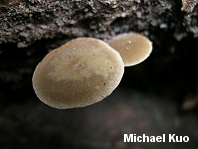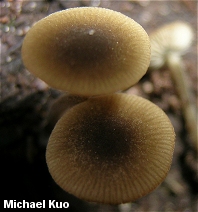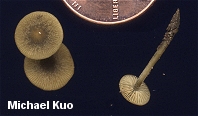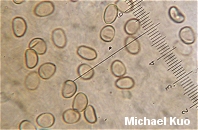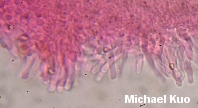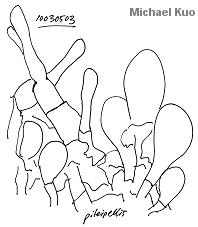| Major Groups > Gilled Mushrooms > Dark-Spored > Wood-Rotting LBMs > Simocybe centunculus |

|
Simocybe centunculus [ Basidiomycetes > Agaricales > Crepidotaceae > Simocybe . . . ] by Michael Kuo Simocybe centunculus is widely distributed and fairly common in North America, but is almost never treated in field guides. Perhaps it has simply been passed over as another LBM ("Little Brown Mushroom")--but while it is tiny and brownish, it has enough distinctive features to make it fairly easy to recognize, even without microscopic analysis. You will have to squint, since penny-sized caps are large for this species, but you are looking for:
Microscopic features will confirm identification--and since these features are rarely characterized or illustrated I have provided extra illustrations and microscopic data below. DNA studies have placed Simocybe centunculus and other members of the genus Simocybe next to Crepidotus in the Crepidotaceae (see Moncalvo et al., 2002 and Aime et al., 2005). Description: Ecology: Saprobic on the dead wood of hardwoods; often found on stumps, but also on fallen logs; appearing on old, decorticated (barkless) wood as well as on wood with bark still attached; summer and fall (but occasionally seen in late spring or in winter during warm spells); widely distributed in North America. Cap: 1-2.5 cm; convex becoming flat; dry; finely velvety or powdery, becoming smooth; olive to olive brown, fading markedly as it dries out; usually with a dark center and a paler marginal area by maturity; finely lined. Gills: Attached to the stem; close; whitish or pale brownish, becoming brown to olive brown; with whitish, frayed-looking edges. Stem: 1-3 cm long; under 5 mm thick; equal; frequently curving in order to align the cap for spore dispersal; smooth but adorned with tiny white flakes near the apex; colored like the cap; hollow; with whitish basal mycelium. Flesh: Insubstantial. Odor and Taste: Odor not distinctive or slightly unpleasant to spermatic. Spore Print: Brown. Chemical Reactions: KOH red on cap surface. Microscopic Features: Spores 6-8 x 4-5 µ; smooth; mostly kidney-shaped but a fair number deviating to subglobose, sublacrymoid, or subelliptical; dingy yellowish in KOH or Melzer's reagent. Basidia clavate; 4-sterigmate. Pleurocystidia absent. Cheilocystidia abundant to scattered; cylindrical to cylindrico-clavate; up to 60 x 6 µ. Pileipellis a densely interwoven trichoderm with inflated terminal elements (a "hymeniform layer") embedded in poorly defined material, with frequent (in young caps) to scattered bundles of subcylindric to subfusiform, cystidium-like elements with rounded apices projecting up to 60 µ. REFERENCES: (Fries, 1821) Karsten, 1879. (Saccardo, 1887; Kauffman, 1918; Hansen & Knudsen, 1992; Lincoff, 1992; Moser, 1983; McNeil, 2006.) Herb. Kuo 06170203, 07200200, 10010503, 10030507, 09170603, 09280602. This site contains no information about the edibility or toxicity of mushrooms. |
© MushroomExpert.Com |
|
Cite this page as: Kuo, M. (2007, February). Simocybe centunculus. Retrieved from the MushroomExpert.Com Web site: http://www.mushroomexpert.com/simocybe_centunculus.html |
